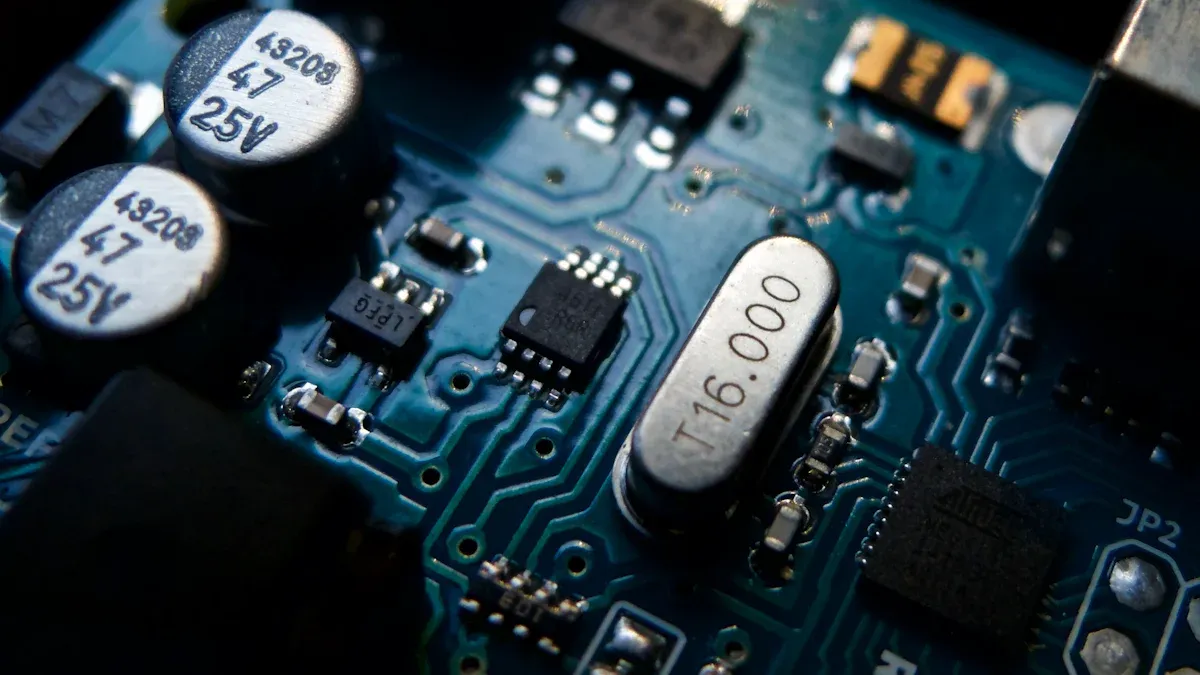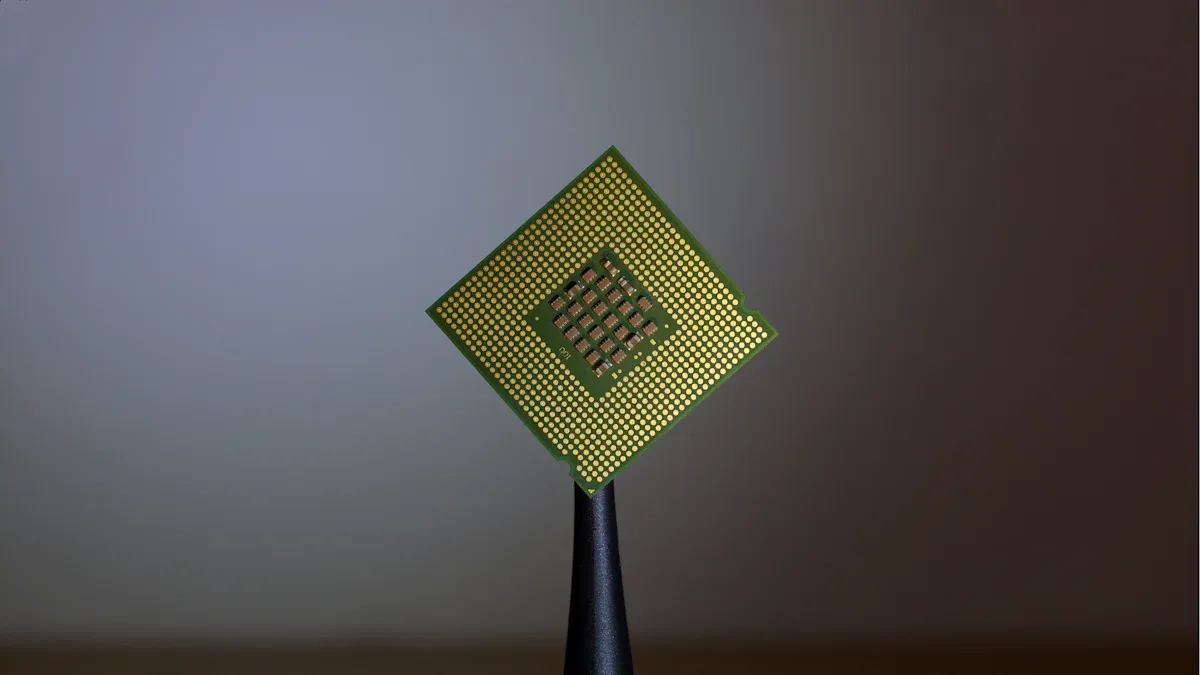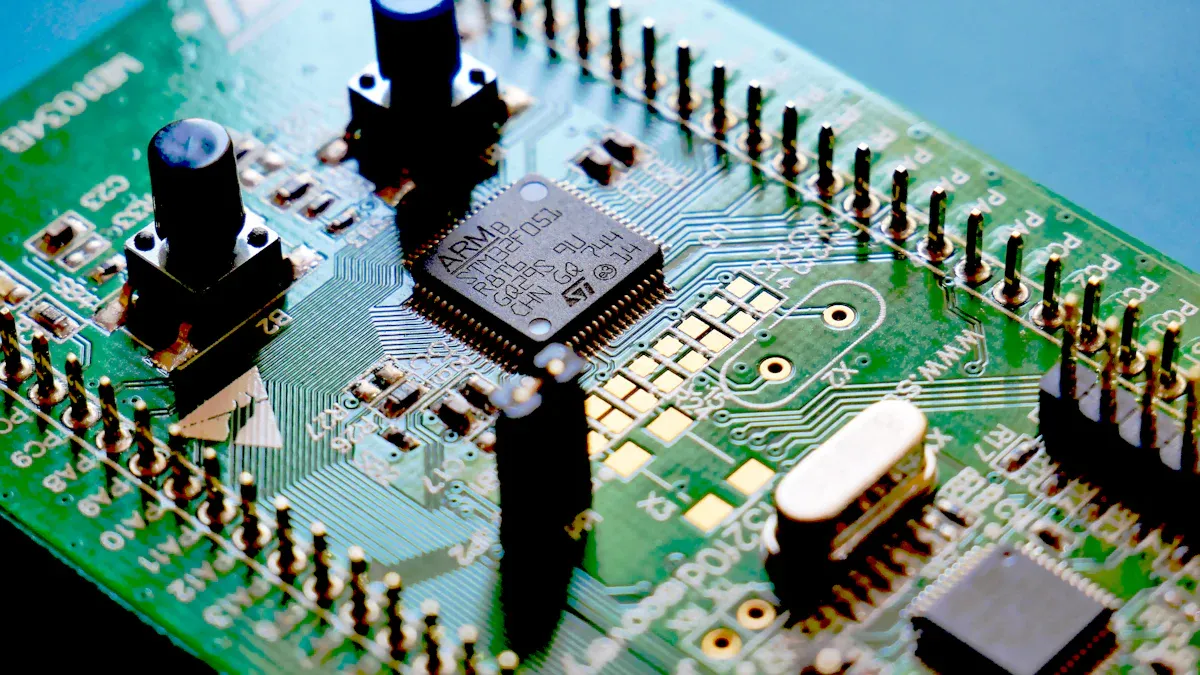Understanding Single Darlington Transistor IC Chip Applications

A single Darlington transistor IC chip combines two transistors into a single unit to amplify current efficiently. This configuration allows you to achieve a much higher current gain compared to a single transistor. Its compact design makes it ideal for modern electronics, where space and efficiency are critical.
The demand for these chips continues to rise. For instance:
The market is expected to grow by 5.40% annually from 2021 to 2028.
Advancements in electronic devices drive this growth by requiring higher efficiency and miniaturization.
You’ll find these chips in power amplifiers, motor controllers, and switching systems. Their ability to enhance performance while reducing energy consumption makes them indispensable in today’s technology.
Key Takeaways
Single Darlington transistor IC chips make weak signals stronger. They are used in things like motor control and audio devices.
Their small size saves space on circuit boards. This helps fit them into modern electronic gadgets easily.
These chips need very little input current, saving energy. This makes them great for devices that use low power.
They have built-in safety parts like resistors and diodes. These protect against voltage spikes and keep them working well.
They give high current gain but have some limits. For example, they can cause voltage drops and switch slower in circuits.
What is a Single Darlington Transistor IC Chip?
Definition and Configuration
A single Darlington transistor IC chip is a compact electronic component that combines two transistors into one unit. This configuration allows the chip to amplify current more effectively than a single transistor. The two transistors are connected in such a way that the current amplified by the first transistor is further amplified by the second. This results in a much higher current gain.
The chip typically includes additional components like resistors or diodes to improve its performance and reliability. These components are integrated into the chip to save space and simplify circuit design. You can find this chip in various electronic devices, where it helps manage current flow efficiently.
Tip: Think of a single Darlington transistor IC chip as a "team" of transistors working together to boost current. This teamwork makes it a powerful tool in electronics.
Key Features and Characteristics
The single Darlington transistor IC chip offers several unique features that make it stand out. Here are some of its key characteristics:
High Current Gain: The chip provides a much higher current gain compared to a single transistor. This makes it ideal for applications requiring significant current amplification.
Compact Design: Its integrated structure saves space on circuit boards, making it perfect for modern, compact electronic devices.
Low Input Current Requirement: The chip requires very little input current to operate, which enhances its efficiency.
Built-in Protection: Many chips include built-in resistors or diodes to protect against voltage spikes or overheating.
Wide Voltage Range: It can operate across a broad range of voltages, making it versatile for different applications.
These features make the single Darlington transistor IC chip a reliable choice for tasks like signal amplification, motor control, and power switching. Its ability to handle high currents while maintaining efficiency ensures its place in modern electronics.
Note: While the chip offers many advantages, you should always consider its limitations, such as voltage drop and slower switching speeds, when designing circuits.
How Does a Single Darlington Transistor IC Chip Work?

Internal Structure
The internal structure of a single Darlington transistor IC chip combines two transistors in a unique configuration. The first transistor amplifies the input current, and the second transistor further amplifies it. This arrangement creates a high current gain. Manufacturers often include additional components like resistors and diodes to enhance performance and protect the chip from voltage spikes.
For example, the TIP125 Darlington transistor IC chip features a silicon-based design with a collector-emitter breakdown voltage of 60V. It operates at temperatures up to 150°C and comes in a TO-220-3 package with three pins. These specifications make it suitable for various applications, including motor control and signal amplification.
Parameter | Details |
|---|---|
Internal Schematic Diagram | Shows the internal structure of the TIP125 Darlington transistor IC chip. |
Collector-Emitter Breakdown Voltage | 60V |
Transistor Element Material | Silicon |
Operating Temperature | 150°C TJ |
Package / Case | TO-220-3 |
Working Principle
A single Darlington transistor IC chip works by amplifying a small input current into a much larger output current. When you apply a small voltage to the base of the first transistor, it allows a larger current to flow through its collector. This current then serves as the input for the second transistor, which amplifies it further. The result is a significantly higher current gain compared to a single transistor.
For instance, Darlington transistors require a base input voltage of approximately 1.4V to activate. Once activated, the voltage drop across the emitter and collector is about 0.9V. This means that if you supply 5V, the load voltage will be around 4.1V. This efficient amplification process makes the chip ideal for controlling large loads with minimal input.
Current Gain and Voltage Drop
The current gain of a single Darlington transistor IC chip is one of its most remarkable features. It is calculated by multiplying the gains of the two transistors. For example, if each transistor has a gain of 50, the total gain can reach up to 2,500. This high gain allows the chip to amplify weak signals effectively.
However, the chip also has a higher saturation voltage compared to a single transistor. This can lead to increased power dissipation. The saturation voltage typically measures around 0.65V in silicon-based designs. While this is a trade-off, the benefits of high current gain often outweigh the drawbacks.
Characteristic | Value |
|---|---|
Current Gain | Ranges from 100 to 1,000 |
Total Current Gain | Up to 2,500 |
Saturation Voltage | 0.65 V in silicon |
Tip: When designing circuits with Darlington transistors, consider the higher voltage drop and power dissipation to ensure optimal performance.
Advantages and Disadvantages of Single Darlington Transistor IC Chips
Advantages
A single Darlington transistor IC chip offers several benefits that make it a valuable component in electronics.
High Current Gain: You can achieve a significant current amplification with this chip. Its unique configuration allows it to multiply the current gain of two transistors, making it ideal for applications requiring strong signal amplification.
Compact Design: The chip integrates two transistors and additional components into a single package. This saves space on circuit boards and simplifies your design process.
Low Input Current: The chip requires minimal input current to operate. This feature enhances its efficiency and makes it suitable for low-power applications.
Built-in Protection: Many chips include built-in resistors or diodes. These components protect the chip from voltage spikes and overheating, ensuring reliable performance.
Versatility: You can use this chip in a wide range of applications, from motor control to signal processing. Its ability to handle high currents and voltages makes it a versatile choice for modern electronics.
These advantages make the single Darlington transistor IC chip a popular choice for engineers and hobbyists alike.
Disadvantages
Despite its benefits, the single Darlington transistor IC chip has some limitations you should consider.
Voltage Drop: The chip experiences a higher voltage drop across the base and emitter, typically ranging from 0.3V to 1.2V. This can lead to increased heat generation, especially when the chip is fully on.
Slower Response Time: The Darlington pair configuration results in slower switching speeds compared to other configurations like the Sziklai pair. This makes it less suitable for high-speed applications.
Power Dissipation: The higher saturation voltage of the chip can cause more power to dissipate as heat. This requires you to implement proper heat management in your circuit design.
Limited Frequency Response: The chip's design limits its ability to handle high-frequency signals effectively. This can restrict its use in certain applications.
While these drawbacks may seem significant, you can often mitigate them with careful circuit design and proper component selection. Understanding these limitations will help you make informed decisions when using a single Darlington transistor IC chip in your projects.
Applications of Single Darlington Transistor IC Chips

Amplification in Audio and Signal Processing
You can use a single Darlington transistor IC chip to amplify audio signals and process weak electrical inputs. Its high current gain and low input current requirements make it ideal for applications like guitar pedals, overdrive circuits, and audio effects equipment. For example, the Tube Screamer pedal, widely used by musicians, relies on Darlington transistors to achieve its signature sound.
The chip’s configuration often includes dual operational amplifiers paired with Darlington transistors. This setup provides a typical voltage gain of 100 dB and an input impedance of 5 MΩ. It operates within a power supply range of ±4 to 18 volts, ensuring compatibility with various audio devices. These features allow you to amplify weak signals without introducing significant noise or distortion.
Specification | Value |
|---|---|
Voltage Gain | 100 dB typ. |
Input Impedance | 5 MΩ typ. |
Power Supply Range | ± 4 to 18 Volts |
Configuration | Dual operational amplifier with Darlington transistors |
Historical Significance | Widely used in guitar pedals and audio equipment |
Common Applications | Overdrive circuits, effects pedals like Tube Screamer |
Tip: If you’re designing audio equipment, consider using a single Darlington transistor IC chip for its ability to amplify signals with precision and clarity.
Switching in Power Electronics
In power electronics, single Darlington transistor IC chips excel at switching applications. Their high current gain allows you to control large loads with minimal input current. This makes them suitable for devices like power supplies, inverters, and battery chargers.
The chip’s sensitivity to small currents enhances its performance in switching circuits. For instance, Darlington circuits can detect currents as low as 0.1 nA, making them ideal for applications requiring precise control. Compared to individual transistors, Darlington configurations amplify currents more effectively, as shown in the table below:
Configuration | Gain | Minimum Current Detected |
|---|---|---|
Darlington Circuit 1 | 40 | 0.1 nA |
Darlington Circuit 2 | 25 | 0.1 nA |
Individual Transistor | 6.67 | 1 nA |
The first Darlington circuit amplified currents as small as 100 pA, demonstrating its sensitivity.
The second Darlington circuit amplified ion current in 100 mM KCl with a gain of 25, which is three-fold higher than the individual transistor's performance.
These capabilities make the chip a reliable choice for switching applications in power electronics. You can use it to manage current flow efficiently while minimizing energy loss.
Motor Control in Industrial and Consumer Devices
Single Darlington transistor IC chips play a crucial role in motor control systems. Their ability to handle high currents and voltages makes them suitable for industrial machinery, robotics, and consumer appliances like washing machines and fans.
When you use these chips in motor control circuits, they provide smooth and efficient operation. The high current gain ensures that even small input signals can control large motors effectively. Additionally, the chip’s built-in protection features, such as resistors and diodes, safeguard against voltage spikes and overheating.
For example, in industrial applications, these chips help regulate the speed and torque of motors. In consumer devices, they enable precise control over motor functions, enhancing energy efficiency and performance. Their versatility makes them indispensable in modern motor control systems.
Note: To optimize motor control circuits, ensure proper heat management and consider the chip’s voltage drop during operation.
Sensor Circuits and Signal Conditioning
You can use a single Darlington transistor IC chip to enhance the performance of sensor circuits and signal conditioning systems. Sensors often produce weak electrical signals that require amplification before further processing. This chip’s high current gain makes it an excellent choice for amplifying these signals, ensuring accurate and reliable data output.
In sensor circuits, the chip acts as an intermediary between the sensor and the processing unit. For example, temperature sensors, light sensors, and pressure sensors generate small voltage or current changes in response to environmental conditions. The Darlington transistor amplifies these small signals, making them strong enough for microcontrollers or other processing units to interpret.
Tip: When designing sensor circuits, always consider the chip’s voltage drop. This ensures the amplified signal remains within the desired range for accurate readings.
Signal conditioning involves preparing a sensor’s output for further processing. This may include amplification, filtering, or converting the signal into a different format. The single Darlington transistor IC chip excels in the amplification stage. Its ability to handle low input currents ensures minimal distortion, preserving the integrity of the original signal.
Here’s an example of how the chip works in a light sensor circuit:
A photodiode detects light and generates a small current.
The Darlington transistor amplifies this current, producing a stronger output signal.
The amplified signal is then sent to an analog-to-digital converter (ADC) for further processing.
Component | Function in Circuit |
|---|---|
Detects light and generates a small current | |
Darlington Transistor | Amplifies the weak current from the photodiode |
ADC | Converts the amplified signal to digital form |
This process ensures that even the faintest light changes are detected and processed accurately. The chip’s compact design also saves space, making it ideal for portable or space-constrained devices like wearable health monitors or IoT sensors.
Note: While the chip offers excellent amplification, its slower switching speed may limit its use in high-frequency sensor applications. Always evaluate your circuit’s requirements before choosing components.
By using a single Darlington transistor IC chip in sensor circuits, you can achieve precise signal amplification and conditioning. This ensures that your devices deliver accurate and reliable performance, even in challenging environments.
Single Darlington transistor IC chips play a vital role in modern electronics. Their ability to amplify current efficiently and handle high loads makes them indispensable in applications like motor control, signal processing, and sensor circuits. You can rely on their compact design and built-in protection features to simplify circuit designs while ensuring reliability.
These chips offer versatility across industries, from consumer devices to industrial systems. Exploring their applications can help you unlock new possibilities in your projects. Whether you're designing audio equipment or power electronics, these chips provide a reliable solution for enhancing performance.
FAQ
What is the main purpose of a single Darlington transistor IC chip?
A single Darlington transistor IC chip amplifies weak electrical signals into stronger ones. You can use it to control high-current devices like motors or enhance signals in audio and sensor circuits. Its high current gain makes it ideal for efficient amplification.
Can you use a single Darlington transistor IC chip in high-speed applications?
No, it’s not suitable for high-speed applications. The slower switching speed of the Darlington configuration limits its performance in circuits requiring rapid signal changes. You should consider alternatives like MOSFETs for such cases.
How do you manage heat dissipation in a Darlington transistor IC chip?
You can manage heat dissipation by using heat sinks or cooling fans. Proper circuit design, such as limiting current flow and ensuring adequate ventilation, also helps. These measures prevent overheating and improve the chip’s reliability.
Are single Darlington transistor IC chips compatible with low-power devices?
Yes, they work well with low-power devices. The chip requires minimal input current, making it efficient for applications like sensor circuits and small signal amplifiers. Its compact design also suits portable and space-constrained devices.
What are the limitations of using a single Darlington transistor IC chip?
The main limitations include higher voltage drop, slower switching speed, and limited frequency response. These factors can affect efficiency and restrict its use in high-speed or high-frequency applications. You should evaluate your circuit’s requirements before choosing this chip.
Tip: Always check the chip’s specifications to ensure it meets your project’s needs.
See Also
Exploring Fundamental Concepts and Uses of Analog IC Design
A Comprehensive Guide to Logic IC Bus Transceivers
Exploring the Function and Applications of Photodiode ICs
An Overview of Digital Integrated Circuits in Electronics
IC Line Drivers Explained: Their Functionality in Electronics
